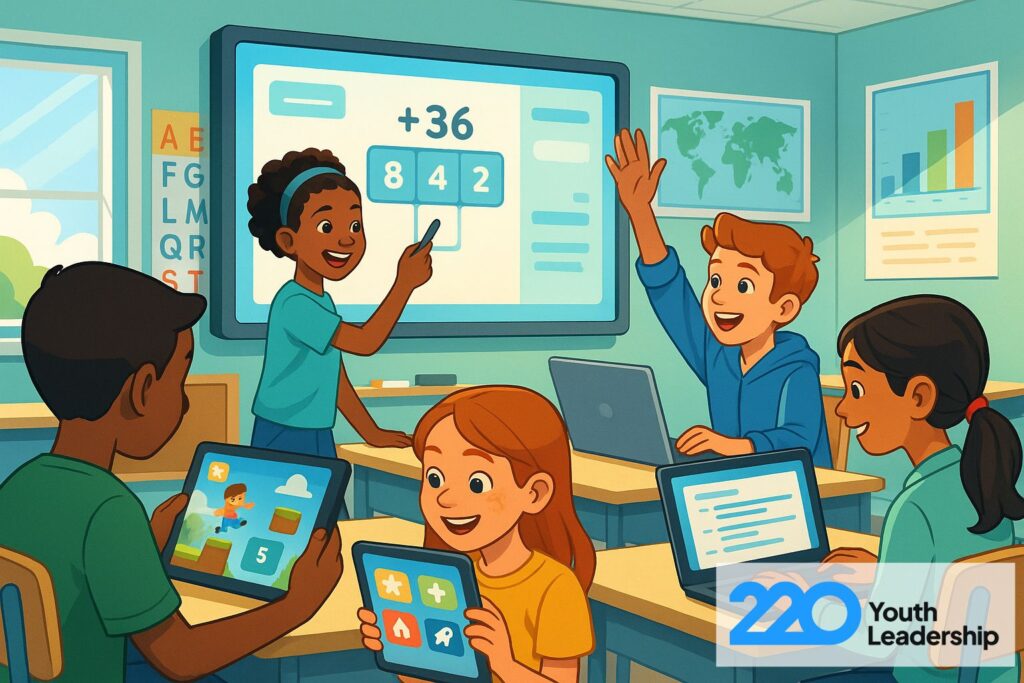
Ever wondered how educational technology can transform a classroom into a hub of excitement and learning? I’m talking about students engaged in interactive lessons, collaborating in real-time, tackling challenges, and making measurable progress at their own pace.
This is made possible by leveraging digital tools like educational apps, augmented reality, and virtual reality, with which teachers can increase student engagement and make education more dynamic and measurably impactful.
In this article, we'll see how classroom technology impacts teachers’ workload, supports various learning styles, empowers students to learn, and helps leadership development.
We will also consider practical examples, data-driven insights, probable challenges, and solutions to ensure students succeed in the classroom, ranging from game-based learning to addressing excessive screen time concerns.
Key Takeaways
- Educational technology greatly improves student engagement through interactive platforms, gamification, and real-time collaboration tools, supporting various learning styles.
- Personalized learning, enabled by adaptive digital tools and customizable content, ensures education meets students’ unique needs, improving their educational experience.
- Integrating technology supports students and reduces teachers’ workload by automating tasks and streamlining communication with parents.
- Technology prepares students for future careers by building critical thinking and problem-solving skills through learning opportunities.
Enhancing Student Engagement with Educational Technology
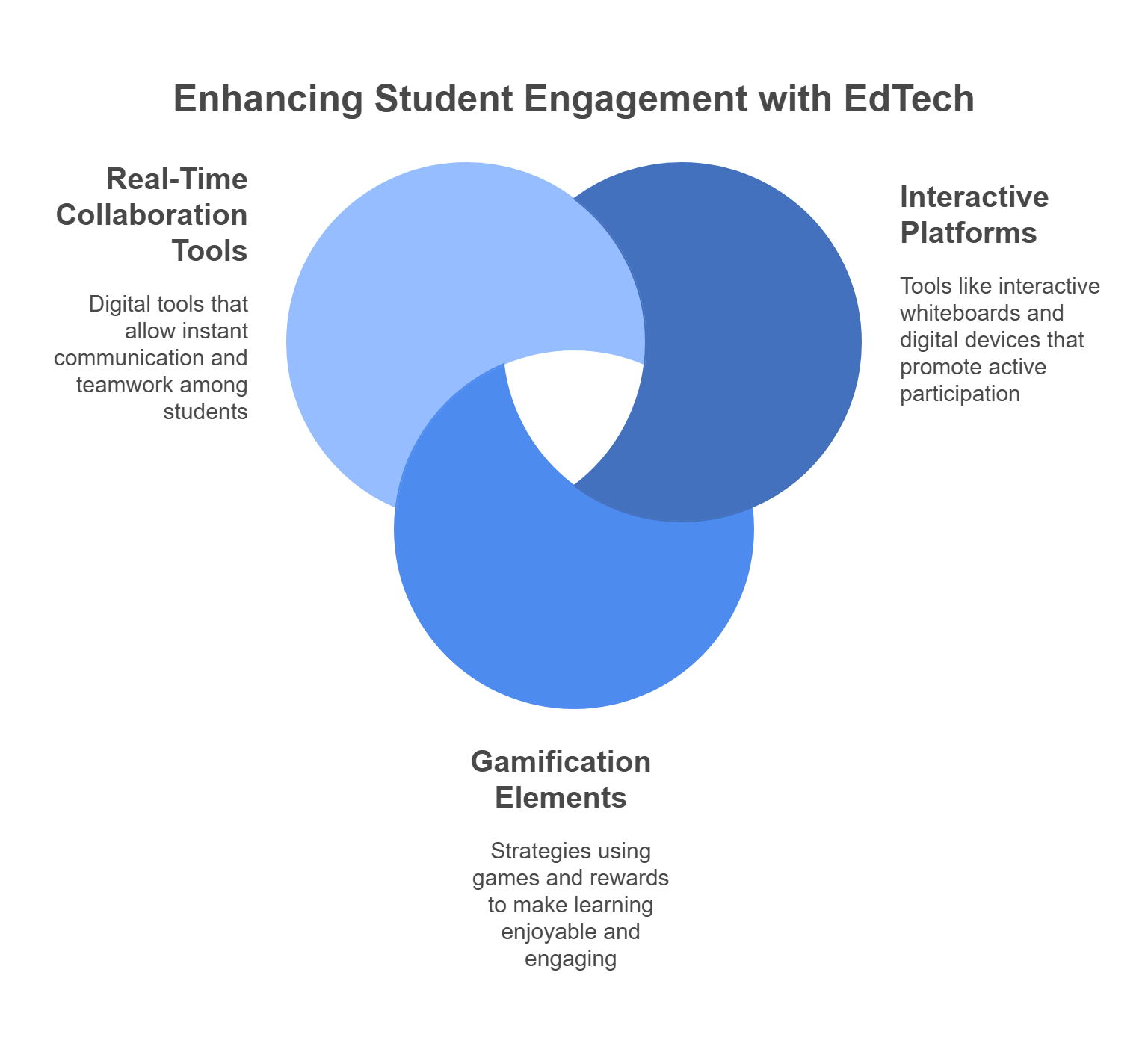
Student engagement is a big deal for teachers, and if you have any teaching experience, you know that a lack of it can make your job quite frustrating.
In fact, we have provided a substantial article on the topic. Educational technology helps with that as it highly impacts student engagement by making lessons interactive, personalized, visually appealing, and memorable, encouraging students to engage actively.
Edtech like interactive platforms, gamification, and real-time collaboration tools drive this change. The use of these digital tools can help teachers create meaningful learning opportunities that ignites curiosity and excitement among students, making education enjoyable, supporting learning styles, and engaging students effectively.
Teachers often use classroom technology to deliver compelling ways of teaching, ensuring students remain actively engaged.

Interactive Platforms
Interactive platforms are vital to educational technology, with tools like interactive whiteboards and digital devices promoting active participation, making lessons engaging for students.
Platforms like Clever and ClassLink provide centralized access to free resources, keeping students focused.
For example, a study observing 226 junior high students found that lessons using interactive whiteboards led to higher levels of student engagement and more appropriate at-task behaviors compared to traditional instruction. Students also reported greater enjoyment and perceived engagement when interactive whiteboards were used as instructional tools.
Not just that. Digital tools offer multimedia content like videos, podcasts, and slideshows, catering to visual learners and enriching the educational experience.
Educational apps like Kahoot turn quizzes into game-based learning. More than that, virtual field trips let students explore concepts like ancient ruins, making abstract ideas concrete. Furthermore, augmented reality and virtual reality reinforce lessons by offering immersive experiences, such as virtual manipulatives for math, helping students grasp complex topics.
Gamification Elements
Gamification has become a powerful tool in education, making complex subjects more approachable and enjoyable for students. By using educational games, achievement badges, and platforms like Classcraft, teachers can encourage students to participate more actively.
The evolution of gamification goes beyond simple point systems. Modern gamification strategies are designed to maintain long-term engagement by continuously challenging and rewarding students. This approach not only makes learning enjoyable but also encourages students to develop essential skills through interactive and engaging activities.
Real-Time Collaboration Tools
Real-time collaboration tools are essential to classroom participation. These digital tools, such as messaging apps, allow students to ask questions, exchange ideas, and collaborate instantly, creating a supportive classroom.
This in turn lets students work on group projects, share ideas, and receive feedback, which is the goal of these interactive sessions.
Teachers can stimulate this experience by using video conferencing for virtual classrooms, ensuring students stay connected, regardless of their location.
Personalized Learning for Diverse Learning Styles

Personalized learning is all about tailoring education to fit each student’s unique needs. That’s where educational technology comes in as it supports a variety of learning styles by offering adaptive digital tools and customizable content.
Plus, with self-paced learning options, students get to move through material at a speed that works best for them, making the whole experience more effective and enjoyable.

Adaptive Learning Technologies
Adaptive digital tools adjust content based on students’ performance, ensuring appropriate challenges. For instance, Doodle Maths adapts to students’ learning capabilities by allowing students learn at their own pace, boosting engagement.
Teachers can use these adaptive digital tools to provide students with tailored feedback, ensuring personalized learning.
Customizable Content Delivery
Customizable content aligns with students’ skill levels. To make this happen, teachers can use digital tools to tailor educational instruction, ensuring students receive relevant content.
For example, Edmodo allows teachers to customize lessons, improving student engagement. When lessons are tailored to students’ interests, skill levels, and learning styles, students feel more connected to the material, which naturally increases their motivation to participate and learn.
Self-Paced Learning
Self-paced learning puts students in the driver’s seat when it comes to their education. With digital tools like classroom tablets and mobile apps, students can progress through lessons at a speed that suits them best.
Beyond that, educational technology often provides a variety of project choices, which not only promotes autonomy among younger learners but also encourages all students to explore concepts on their own.
This approach helps build confidence and encourages a deeper understanding by allowing students to take charge of their learning journey.
Reducing Teacher Workload with Digital Tools
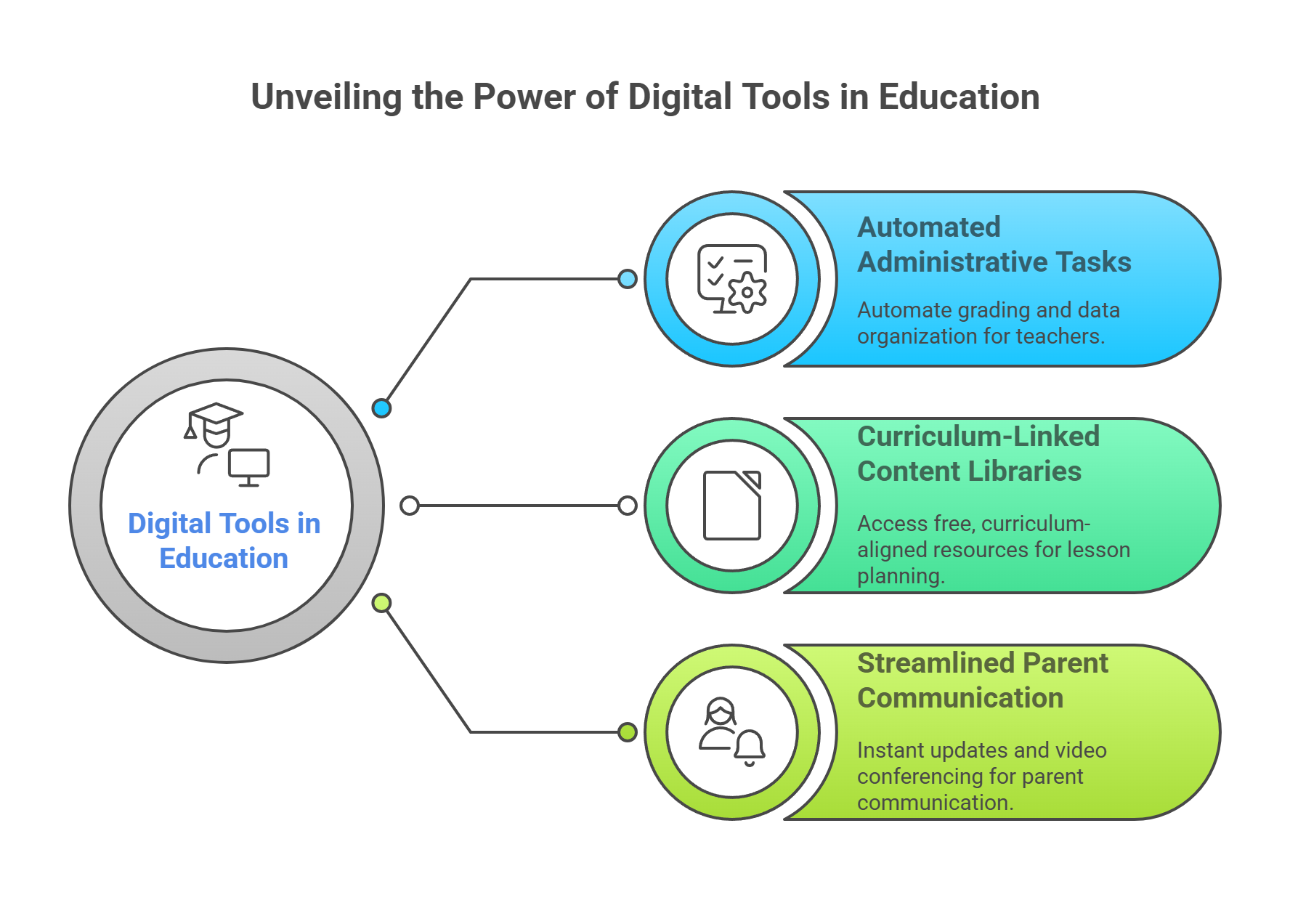
According to research, educational technology supports teachers by facilitating better planning, quick assessment, and resource management, which collectively reduce the time teachers spend on administrative tasks.
The following components work together to make teaching more efficient and manageable.
Automated Administrative Tasks
Automated management systems are a real time-saver for teachers, especially when it comes to grading and organizing data. Take Google Forms, for example. It automatically grades quizzes, which means teachers can spend less time on paperwork and more time focusing on teaching.
In addition, digital management tools help keep student data organized and easily accessible, cutting down administrative headaches. This way, teachers can prioritize what they do best, that is, educating their students.
Curriculum-Linked Content Libraries
Content libraries like CK-12 give teachers easy access to free, curriculum-aligned resources. Because of this, many teachers save a significant amount of time on lesson planning, with some cutting down their planning time by as much time as possible.
Having these relevant materials at their fingertips allows teachers to provide students with targeted content, which helps improve learning outcomes.
Streamlined Parent Communication
Communication tools streamline parent communication by:
- Allowing teachers to share updates about attendance and performance instantly.
- Reducing after-hours email burdens.
- Ensuring that parents are kept informed about their child’s progress.
Video conferencing tools can also facilitate parent-teacher meetings, making it easier for teachers to communicate with parents and address any concerns.
Leadership Development Through Technology
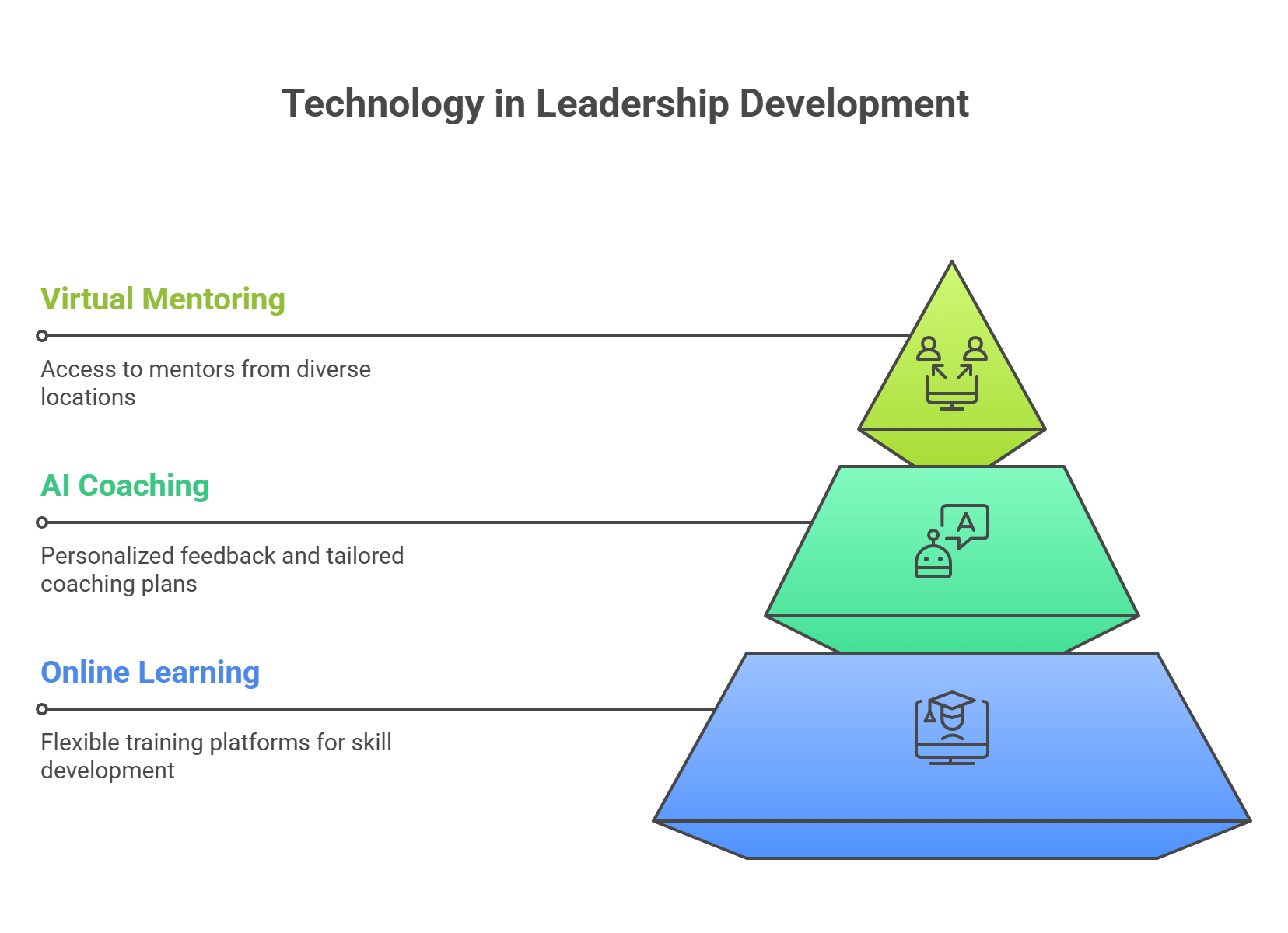
Technology improves leadership programs by offering flexible, scalable training. This section explores digital tools that can help students develop leadership skills, and prepare them for future roles.
Online Learning Platforms
Online learning platforms like Coursera offer flexible leadership training that benefits both educators and students. This flexibility makes it easier for younger students and entire school districts to access valuable learning opportunities. As a result, students can develop important skills remotely, without being tied to a physical classroom.
AI-Powered Coaching Tools
AI-powered coaching tools enhance leadership development programs, providing personalized training for future leaders through artificial intelligence through:
- Processing data to provide real-time feedback.
- Tailoring coaching plans to individual learner needs.
- Encouraging self-assessment to help students reflect on their leadership strengths and areas for improvement.
As AI-powered personalization continues to advance, comprehensive coaching systems are becoming more effective at providing tailored leadership training. These tools ensure that students receive the support they need to develop essential leadership skills.
Virtual Mentoring Systems
Virtual mentoring systems expand access to leadership coaching by connecting students with mentors from various geographical locations, breaking traditional barriers. These systems offer a broader network of support, allowing students to benefit from different perspectives and experiences.
Virtual mentoring in leadership development programs also provides students with valuable guidance and support from experienced mentors, regardless of location.
This approach ensures that every student has the opportunity to develop their leadership skills and build a strong network of mentors.
Developing Digital Literacy and 21st-Century Skills
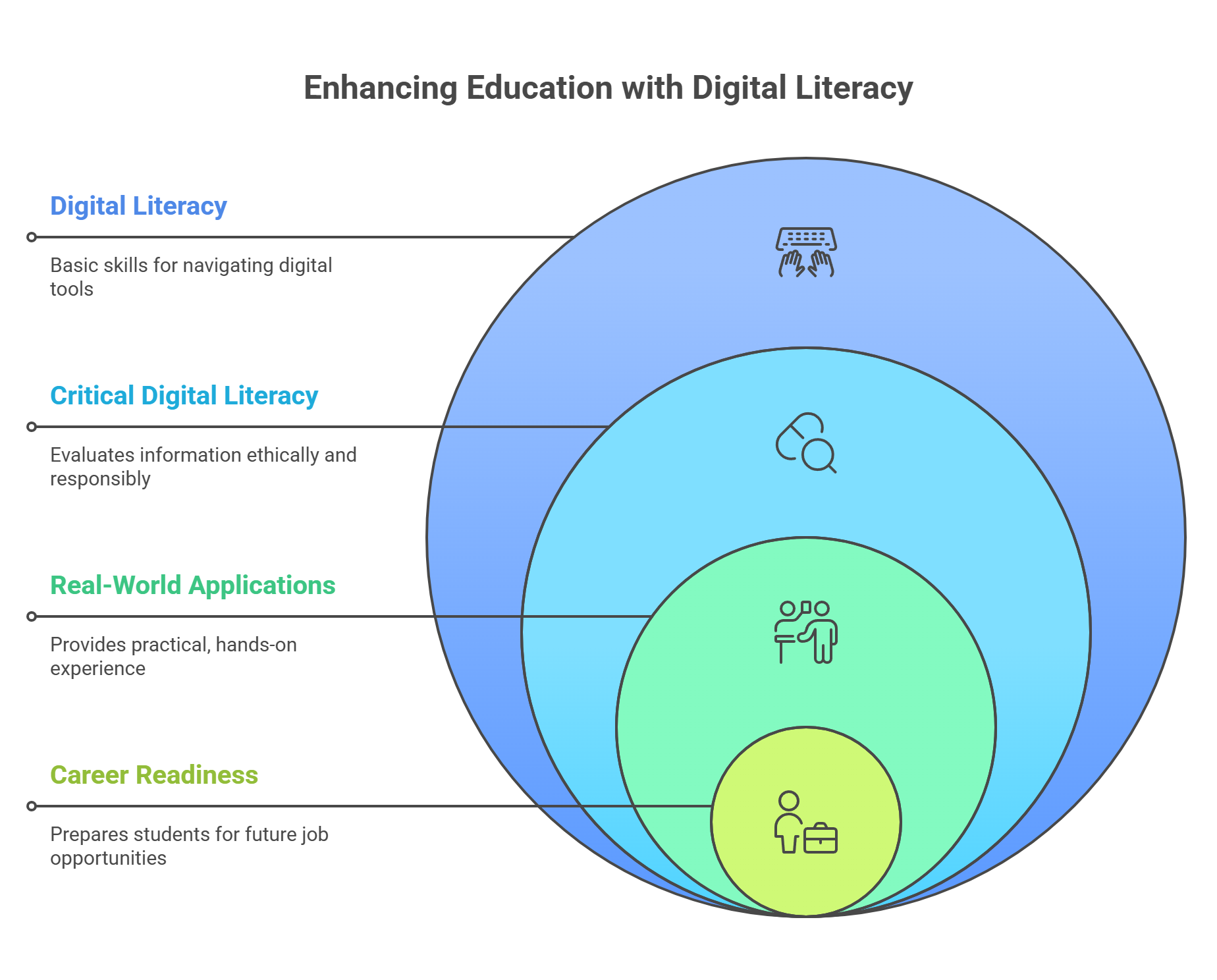
Educational technology builds digital literacy, critical thinking, and problem-solving for students. That's why integrating technology prepares students for a fast paced digital world, ensuring access to job opportunities.
Critical Digital Literacy
Digital literacy goes beyond basic skills. It includes evaluating information ethically. To achieve this, teachers can guide students to use search engines responsibly, ensuring students find credible sources.
Moreover, digital tools like Google Workspace help students communicate effectively, which in turn prepares them for success in professional environments.
Real-World Applications
Technology-based assignments, such as coding projects, play a key role in developing students' problem-solving skills. Building on this, collaborative platforms like Microsoft Teams simulate real workplace teamwork, giving students the opportunity to gain practical, hands-on experience. Additionally, virtual field trips bring abstract concepts to life, enabling students to apply their learning in meaningful and concrete ways.
Preparing for Future Careers
When it comes to getting students ready for the future, digital literacy, coding, and data analysis readily take the center stage. What’s more, using tools like Google Drive and spreadsheets gives them hands-on experience that’s directly applicable in the workplace.
On top of that, educational technology helps students keep pace with the fast-changing job market. In fact, a lot of teachers have noticed just how much better prepared their students are for their careers thanks to these tech skills.
Supporting Special Populations with Accessible Technology
Educational technology advances accessibility by providing tools like virtual manipulatives and videos. In addition, its ability to be customized supports multilingual learners and students with special needs, thereby helping to create more inclusive classrooms.
Assistive Technologies
Assistive technologies play an important role in supporting communication and learning for students with special needs. Examples include text-to-speech and closed captioning, which improves accessibility for students with diverse learning needs. These technologies also aid in the development of fine motor skills and provide creative expression opportunities.
Starting tech early in childhood correlates with improved kindergarten readiness skills, showing how important these tools are in early education. By integrating assistive technologies, educators can create inclusive learning environments that support all students’ various needs.
Multilingual Learners
Supporting multilingual learners is essential for creating an inclusive classroom environment. Dual language learner support includes:
- Providing translation tools and multilingual resources to enhance comprehension and engagement.
- Utilizing bilingual books and language apps to promote educational equity.
- Ensuring that all learners have access to the resources they need to succeed.
Technology that supports multilingual learners enables educators to create a more inclusive and effective learning environment.
Economic Equity Advancement
Making sure every student has access to essential technology is fundamental for economic equity in education. The cost of buying and maintaining digital tools often creates big barriers, limiting access and widening the gap between wealthy and under-resourced schools.
While well-funded schools enjoy the latest devices, others struggle just to provide the basics, deepening educational inequalities.
Thankfully, educational grants and programs can help cover these costs for students who need it most, giving them a fair chance to learn and get comfortable with technology.
Overcoming Implementation Challenges and Training Requirements
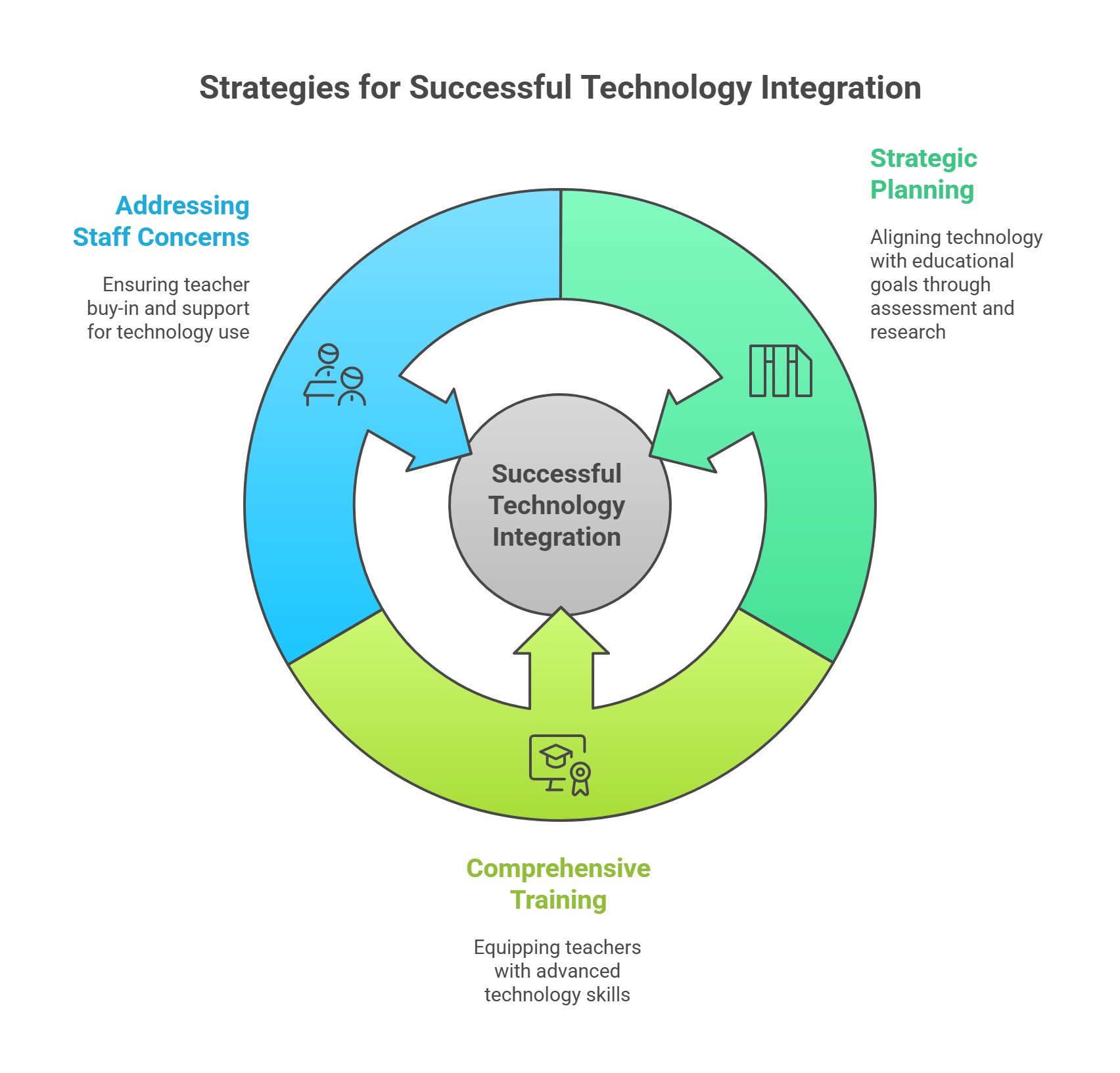
Integrating technology comes with its own challenges. Some of them include:
- High costs,
- Lack of ongoing support,
- Ease of use,
- Technical issues like internet connection failures and battery problems.
For teachers to move past this and be more effective, administrators can consider the following ways to support.
Strategic Planning
Strategic planning is one of the surest ways to align technology with education goals. To begin, school districts can:
- Assess classroom needs.
- Research digital tools like Kahoot.
- Apply for grants like E-Rate.
- Train teachers on educational technology.
These things take time. That's why dedicating substantial time to strategic planning ensures that technology choices align with educational objectives and enhance the learning experience.
Comprehensive Training Programs
Many teachers report a rapid improvement in integrating technology after training, which shows that educators need training beyond basic skills. Programs like Google’s Educator Certification equip teachers to incorporate technology, allowing teachers to make lessons more effective.
Addressing Staff Concerns
Staff buy-in and change management challenges require addressing teacher concerns to provide teachers with successful technology integration.
Ongoing support systems are necessary to ensure that teachers feel supported and confident in using technology in their classrooms.
By addressing staff concerns and providing ongoing support, a positive attitude towards technology integration is encouraged, thereby ensuring its successful implementation.

Summary
If there's anything that has been emphasized all through this article, it's that embracing technology transforms education for students and teachers. We've also seen that educational technology boosts student engagement, supports personalized learning, reduces teachers’ workload, and develops leadership skills.
Also, technology ensures students succeed by building digital literacy and supporting special populations. Adequate training, and funding opportunities like grants address challenges, allowing students to succeed.
As we wrap up, join 220 Youth Leadership in embracing technology to maximize student engagement. Together, we can transform classrooms and prepare students for a successful future in the digital age.
Frequently Asked Questions
How does educational technology increase student engagement?
Educational technology makes lessons interactive, supporting learning styles and keeping students engaged through digital tools.
What are the benefits of adaptive learning technologies?
Adaptive digital tools offer personalized learning, allowing students to progress at their own pace, improving outcomes.
How can technology reduce teachers’ workload?
Digital tools automate tasks and track students’ progress, allowing teachers to focus on making lessons effective.
What role do AI-powered coaching tools play in leadership development?
Integrating AI provides personalized feedback, helping students learn leadership skills effectively.
How can schools support multilingual learners with technology?
Digital tools like translation apps improve comprehension, allowing students to engage in education.